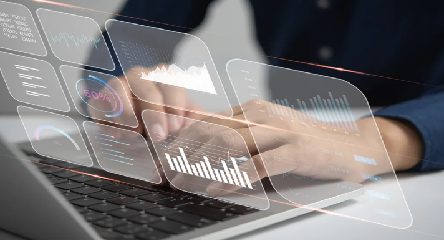Upgrade To A CMMS
CMMS Drives Continuous Improvement In Maintenance Operations
A well-designed and managed maintenance program is a major contributor to the performance and profitability of a business. The days of managing work orders, assets and maintenance using paper and spreadsheets are quickly vanishing. Managers are recognizing that relying on these methods to manage their data is unreliable and time-consuming. In order to keep up with the competition, businesses need to find a solution that can help them manage their facilities and maintenance operations more efficiently, is flexible and can continue to rapidly grow as their company expands, and be cost-effective.
Companies are looking to streamline processes, improve productivity, cut costs, manage labor and be able to show the measurement of success. The effective use of a Computerized Maintenance Management System (CMMS) is an integral tool for achieving this success in any maintenance strategic master plan. A CMMS stores all of your company’s maintenance processes and data into one centralized system, accessible from anywhere through an easy to use portal.
Let’s look at how a CMMS continually impacts the success of any maintenance management program. The core features of this software combined with the demands of companies wanting a cost-effective system with all the bells and whistles make a CMMS the perfect solution. This web-based solution can be managed and is accessible from a computer, smartphone or mobile device.
Improve Operational Efficiency
Maintenance
A CMMS provides businesses with the tools to manage their preventive maintenance program. Proper routine maintenance will extend the life span of equipment and assets. Well maintained equipment will reduce downtime and unexpected expenses.
Measurements: (Just a few of the measurement tools within CMMS.)
- Reports, dashboards and interactive calendars are available to provide real-time information on when preventive maintenance tasks are scheduled, sent, received, and closed. You can also view preventive maintenance tasks by department, location, vendor, and equipment type.
- View historic data, identify trends and resolve issues before they occur.
- Generate reports to show the total Cost of Assets, providing information on breakdowns, labor and parts costs associated with each asset, giving management the ability to compare the true costs of related or comparable assets over time.
- Mean time To Repair (MTTR) reports, measuring the average time required to troubleshoot and repair failed equipment.
- Mean Time Between Failure (MTBF) measures the average time that equipment is operating between breakdowns or stoppages.
- And more reports.
Improve Workflow
Work Orders are the focal point of any CMMS, and it is critical for users to have access to as much information as possible from within the work order screen.
Measurements: (Just a few of the measurement tools within CMMS.)
- Provide work order history, time spent on performing a job, statistics and analysis tools.
- Run reports and create dashboards to show the status of work orders.
- Reports showing asset downtime, labor hours and expenses.
- Store documents, drawings, images, warranty, safety and other pertinent information.
- And more reports.
Improved Resource Management
Resource management seamlessly integrates with eWorkOrders CMMS. This feature gives users the ability to assign and prioritize resources to any scheduled or on-demand work orders.
A CMMS also gives users access to vendor contact information making it easy to quickly assign work to vendors and notify them by email with the work order details.
Measurements: (Just a few of the measurement tools within CMMS.)
- Resources can enter the hours they have worked on each work order.
- Reports can be run to track and calculate the total labor costs.
- Labor and invoice costs are tracked and reported on through maintenance history reports, allowing managers to see real-time or historical data on employee utilization rates, response times, work completed late, and labor and outsourcing costs.
- Vendor reports can be generated on costs, work order performance, and response time.
- And more reports.
Communications
Using a CMMS to streamline and centralize communications, stores your digital records, providing users with more accurate information and eliminating excessive emails, phone calls and messages. With users having access to real-time information, they are better informed and can concentrate on other tasks.
Measurements: (Just a few of the measurement tools within CMMS.)
- Automatic notifications when requests come in, work is assigned, notes are updated and work is completed.
- Users are looking at one centralized database with the most up-to-date information.
- Improvement in response time due to having logs and information instantly available.
- Clearly defined information improves communication.
- Less chance of errors or lost information.
- Mobile access from anywhere at any time.
- And more reports.
Reduce Costs & Increase Profitability
With a CMMS to manage maintenance operations, organizations can streamline processes and increase efficiency. With preventive maintenance and the focus on maintaining assets and equipment, organizations can reduce and manage the costs that cut into the bottom line.
Measurements: (Just a few of the measurement tools within CMMS.)
- Run reports to analyze asset history, repairs, expenses, downtime, labor, etc.
- Keep track of labor and vendor hours and expenses.
- Increase in productivity.
- Decrease in expenses.
Regulatory Compliance
With a CMMS maintenance professionals can minimize the headache of meeting audits and regulatory compliance standards. All of your processes and information have been documented and stored in one centralized location, giving organizations the ability to pull reports at any time.
Measurements: (Just a few of the measurement tools within CMMS.)
- Easily run detailed historic reports that show the processes, scheduling, maintenance tasks and work orders to comply with safety and environmental regulations.
- Ensure standard operating procedures are being followed.
- Keep staff accountable for their work.
- And more reports.
Conclusion
CMMS has now become an essential part of how businesses run in this new day and age. Organizations are looking for the tools to help them manage their maintenance operations, increase efficiency, be cost-effective and be flexible to meet their growing demands. Having a CMMS develops organizational intelligence, which in turn leads to managers making better decisions that result in higher profits. eWorkOrders provides users with the right solution to meet any size business need. Call today to speak with one of our CMMS Account Executives, who will spend the time to understand your requirements and provide you with the right solution.





